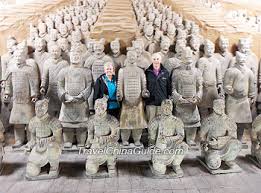
The Enigmatic Terracotta Army: Unveiling the Secrets of Qin Shi Huang's Silent Legion
Qin Shi Huang's Mausoleum stands as an unparalleled testament to imperial ambition and architectural prowess. This sprawling necropolis, a microcosm of the First Emperor's vast empire, is renowned worldwide for its sheer scale and the intricate details woven into its design. Among its most captivating features is the Terracotta Army, an assembly of thousands of life-sized terracotta warriors, chariots, and horses, standing in silent vigil for over two millennia. But just how many figures comprise this awe-inspiring legion?
A Monument Built on Unprecedented Scale
The construction of Qin Shi Huang's Mausoleum was an undertaking of epic proportions, demanding resources and manpower on an unprecedented scale.
-
** Sourcing the Finest Materials:** The creation of such a monumental complex necessitated sourcing vast quantities of raw materials, each meticulously selected for its quality and suitability. Timber, renowned for its durability, was transported from the distant mountains of Sichuan, while the finest clay for the terracotta figures was sourced from nearby deposits, chosen for its fine texture and ability to withstand the test of time. Each material was entrusted to skilled artisans and craftsmen, who applied their expertise to transform these raw elements into the building blocks of the mausoleum.
-
** A Nation's Labor:** Historical estimates suggest that the construction of the mausoleum spanned several decades, engaging a workforce that fluctuated in size throughout the project. At its peak, some historians believe that as many as 700,000 laborers, conscripted from across the newly unified empire, toiled tirelessly on the construction of the Emperor's final resting place. This colossal mobilization of manpower underscores the immense importance placed upon the mausoleum's completion and its significance in solidifying Qin Shi Huang's legacy.
The Silent Sentinels: An Archaeological Enigma
The existence of the Terracotta Army remained shrouded in mystery for centuries, its discovery in 1974 by local farmers an event that sent shockwaves through the archaeological community and captivated the world's imagination.
-
Absent from Ancient Records: Intriguingly, no known historical records mention the Terracotta Army, making their unexpected discovery all the more remarkable. This absence from official documentation has fueled much speculation among scholars, who have put forth various theories, ranging from attempts to protect the site from tomb raiders to the possibility that the knowledge of their creation was intentionally suppressed.
-
** A Legacy Preserved:** The Terracotta Army's omission from historical texts may have inadvertently contributed to its remarkable preservation. Hidden beneath layers of earth and undisturbed for over two thousand years, the figures have largely withstood the ravages of time, offering an unprecedented glimpse into the military might and artistic sophistication of the Qin Dynasty.
FAQs
Q: How many warriors are estimated to be in the Terracotta Army?
A: While excavations are ongoing, it is estimated that the Terracotta Army comprises over 8,000 life-sized soldiers, 130 chariots with over 500 horses, and a further 150 cavalry horses.
Q: Were all of the Terracotta Warriors originally painted?
A: Yes, evidence suggests that the Terracotta Warriors were originally adorned with vibrant pigments, adding a lifelike quality to their appearance. However, exposure to air upon their rediscovery caused much of the paint to flake away.
Q: Why was the Terracotta Army created?
A: The precise purpose of the Terracotta Army remains a subject of scholarly debate. The prevailing theory suggests that they were intended to serve as a symbolic army, protecting Qin Shi Huang in the afterlife and ensuring the continuation of his rule.